Forum Replies Created
-
AuthorPosts
-
 Tony RoddaParticipant
Tony RoddaParticipantAnd those NUCs are starting to come up refurbed on ebay for way less than £100!
As Dominic says, add a larger SSD (or better still offload images to a server real time) and bingo.
I also looked at the Odroid with Linux. An Octa-core machine.
Much appreciated fellas.
 Tony RoddaParticipant
Tony RoddaParticipantThat’s exactly the feedback I’m looking for. Thanks for taking the time.
Regards Tony
2 September 2020 at 8:45 pm in reply to: Paper includes supernova classified using the ALPY200 #583074 Tony RoddaParticipant
Tony RoddaParticipantSuperb work.
 Tony RoddaParticipant
Tony RoddaParticipant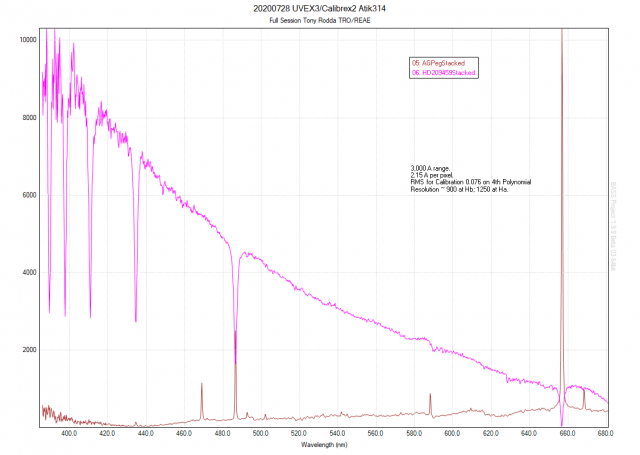
 Tony RoddaParticipant
Tony RoddaParticipantHi Bill,
The photo shows two elements of what will be a fully robotic remote controlled spectrograph – based on a classical optical design. This is being developed by myself and half a dozen American friends some of whom I’ll mention directly.
The large board houses the RW ‘book’ circuit modified by Clarke Yeager to allow remote working. He designed the PCB which also houses a Nano BLE Sense for control of focusing, slit illumination, grating position, etc. We envisage mount sensing, direction and environmental monitoring too. The smaller box is a calibration injection unit, designed by Jerry Foote. Software is being written by Tom Smith and the overiding architecture is by Wayne Green. They’ll probably use a Pi/Odroid from overall command functions. I’ll go with whatever they decide. (A guy called Woody Sims keeps us in the real world!). There are several others who bring unique skills to the team but I’ll spare the roll call but they’re all under the Society of Astronomical Sciences out of the US west run by Bob Buckheim.
It’s a neat team and we recently published an update paper. More to follow as we make progress.
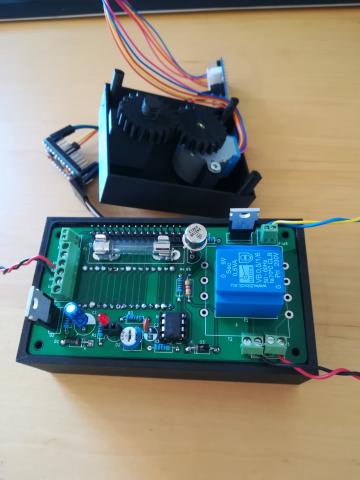
 Tony RoddaParticipant
Tony RoddaParticipantNo, I experimented with Thorlabs 4, 7 and 11 degree prisms and settled on the 6. (I think the PH is 4 degrees?).
The “11” worked best but deviated the beam too much for my SXVH9 camera chip. A bigger camera would probably work but I couldn’t retask my Atik460.
Anyway, the easiest assembly method is to use standard eyepiece holders/spacers and just screw the four components together! An optical train of 50mm collimating lens, prism, grating and 80mm camera lens as per Burwitz’s design. A guider at one end (Paul Gerlach’s works well) and an camera connector at the other such as a T2/1.25″ nosepiece type. All that’s needed is a printed tube/jacket so that the assembly can be rotated/focused at each end (to align the prism/grating with the slit and the camera).
Having built it I now know what needs putting right (!) and I’m redesigning the optics holders and guider. I’ll ‘publish’ the stl files in a couple of weeks.
Regards
T
 Tony RoddaParticipant
Tony RoddaParticipantHi Robin,
It sould be around R=400 @550nm for the 23um slit.
Vadim Burwitz got 350 with a much larger pixel camera.
Here’s a quick neon test run.
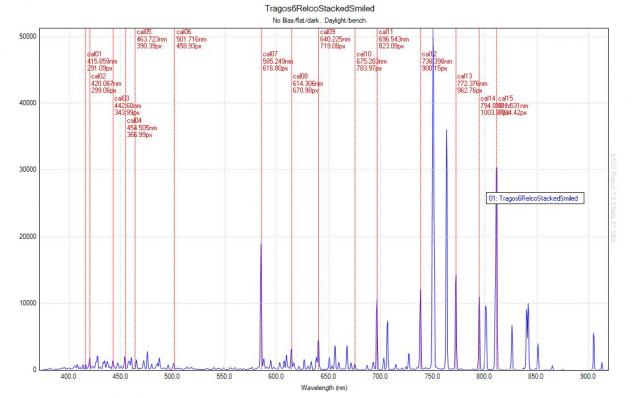
Regards
T
 Tony RoddaParticipant
Tony RoddaParticipantRegards
T
 Tony RoddaParticipant
Tony RoddaParticipantRegards T
 Tony RoddaParticipant
Tony RoddaParticipantYes, you’re right, the chromatic aberation seems less of an issue with this ‘restricted’ mode of operation. In fact the focus and calibration fit is incredibly good (even for a simple linear fit). Still needs proving ‘at the scope’ though.
That’s great stuff by Terry. The range and resolution looks like a similar config. That gives great hope. Simspec suggests R~ 8000 for an 1800 + H9. See below.
I’m still using ‘not quite the best’ optics but I exacerbated the ‘elephants foot’ problem because I did something really dumb during the design stage…
When I rescaled the camera lens to fit a larger item (same focal length) I unintentionally scaled the base/holder too. This raised the lens off the optical axis. Dopey or what?
I recognised the mistake when I stripped, cleaned and rebuilt the spectroscope ready for ‘final’ testing at the ‘scope. I think I’d been so focused on keeping all the components orthogonal that I’d simply missed it.
Anyway, new holders fitted. That, and more careful placement of the calibration lamp (!), have produced much better results.
Attached below are pictures from both the ‘re-adjusted’ spectros but using a SXH9 camera (1392 pixels) instead of the little Orion. You can still see a small amount of line definition loss but this can be helped with careful lamp placement. Still, I think that’s as far as these optics/configs can be pushed.
Anyway, very peasing results (albeit need to be proved in real life!) but enough success to warrant fitting better optics and a full resolution print. I’d produced some decent test spectra on the few occassions I was able to mount the devices at the scope but there was nothing I’d want to submit. That is, nothing that matched the accepted standard. This gives me hope.
1800 l/mm 30um slit ‘tuned’ to Ha…
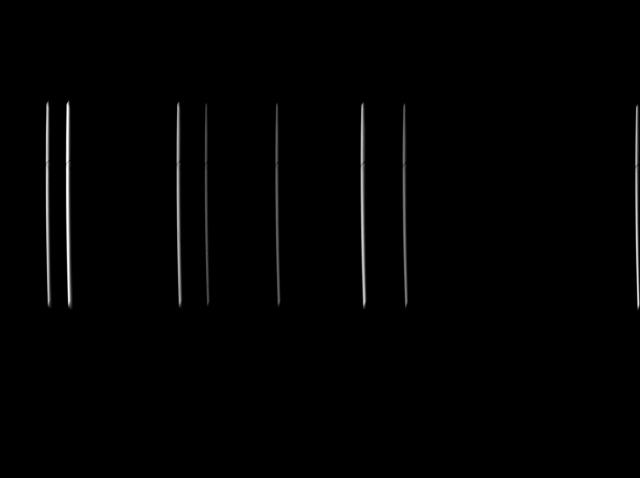
Spectro number 1, 600l/mm – 40um slit at 600nm to 750nm…
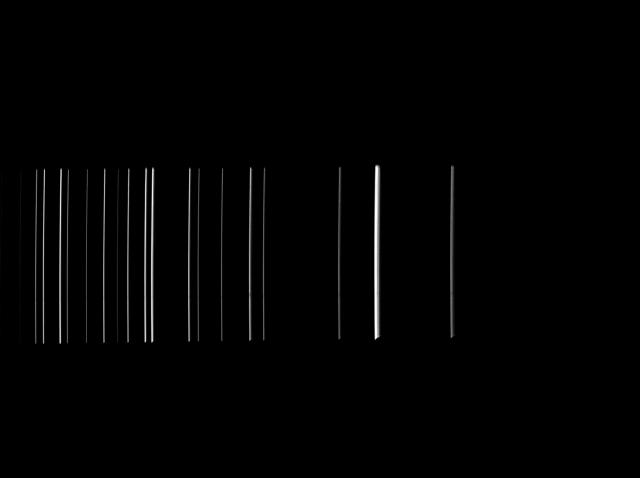
A ‘refined’ guide image using a 40um slit (which might be to wide a FoV)… I’m still experimenting with different lenses to find the best options – but that won’t happen until I get to use them in anger.
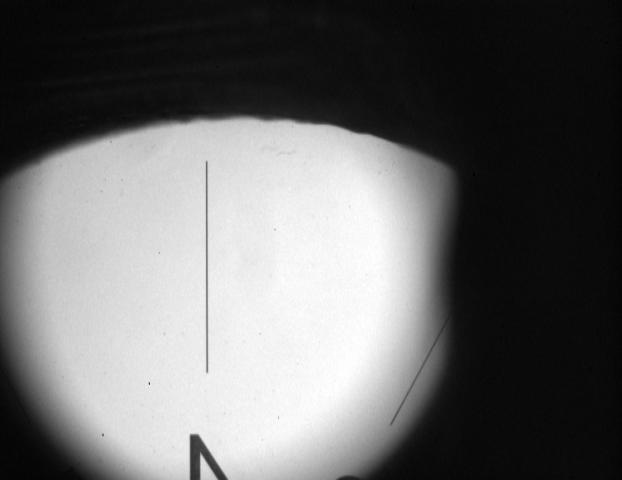
 Tony RoddaParticipant
Tony RoddaParticipantSorry for being off-grid recently – a very unpleasant cold after returning to the UK!
Yes, the vernier adjusts the grating as standard. I’d just placed everything so as to zero in on Ha. I can effectively ‘lock-off’ the adjustments to stay Ha orientated. That’s what I crudely mean by Ha ‘tuned’.
I’ve just refitted both the ‘printed’ scpectroscopes ready for observing – just need a break in this terrible weather! Oh, for Arizona skies!
PS, I got Wayne’s latest treatise and will respond asap.
Regards T
 Tony RoddaParticipant
Tony RoddaParticipantThanks for the suggestion Paul.
It took a while to get the local ansvr configured and running but it’s going now. A little slower than PS2 I have to say but it’s usable. I’ll review that statement when I do a long photometry run!
I like the labelling and Simbad links. It’s a step up from AIP4WIN and must have a better development path – especially for a free package.
I’ll give it a try and see what happens.
Regards
T
 Tony RoddaParticipant
Tony RoddaParticipantTransiting Exoplanets. By Carole Haswell no less. Superb.
Regards
 Tony RoddaParticipant
Tony RoddaParticipantTaken a few weeks ago.
Rgds T
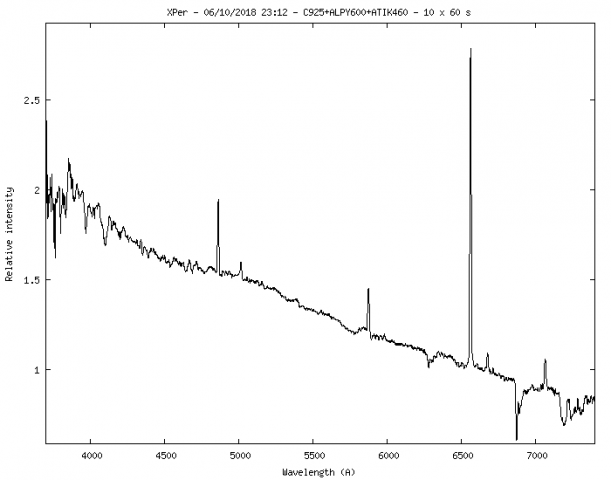
 Tony RoddaParticipant
Tony RoddaParticipantSo much so, a plane has just tried to land in my garden.
 Tony RoddaParticipant
Tony RoddaParticipantIf you stick a pin in the centre of the UK?
 Tony RoddaParticipant
Tony RoddaParticipantI really appreciate the detailed response.
Yes, I’d generated a defect map and had applied that. But hadn’t thought about treating a subframe so that’s an easy fix for me.
I’d applied the same rotate, tilt and binning by default. That is, without specific intent but I’ll ensure that i do that now. I’m assuming you mean the same ‘size’ binning area (and not the same physical position on the frames).
With regards the ‘freehand’ curve I followed the same technique as in ISIS. I do have the ‘Free Draw’ box ticked in the Response Shaper tool (not the ‘Linearise’ box) but I select multiple points on the spectrum to produce a ‘curve’ as in ISIS. Are you saying I should I use Linearise?
Also, when using a reference spectrum from the Miles db do you routinely use ‘normal’ or ‘Dereddened’?
As for the workflow, let me know if you want it amended and I’ll share with the community (or send to JohnP) if you think it useful.
Regards T
 Tony RoddaParticipant
Tony RoddaParticipantHeII 4686A!!
What a good summary that document is. Saves wading through the myriad of textbooks.
Regards T
 Tony RoddaParticipant
Tony RoddaParticipantThanks, T.
 Tony RoddaParticipant
Tony RoddaParticipantRather perversely I’ve gone from ISIS and Demetra to BASS in order to process spectra from my home made stuff. Refreshers, practice and ‘advanced’ techniques (such as Spectrophotometry?) are always welcome.
The BAA workshop for the ALPY600 was excellent simply from the position of talking with fellow users.
One plea though… Can we do the midlands area?
Regards T
-
AuthorPosts
